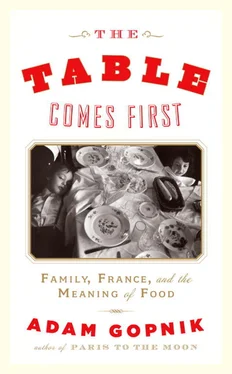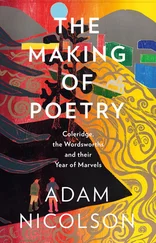Yes, I digress. Elizabeth Pennell is the rare kind of food writer who makes you digress, turn from analytic scrutiny to ardent fantasy.
Pennell’s recipes are all usable still, and her advice on seasonal dining is the best before Richard Olney. (She likes only light desserts, and insists on steak with shallots and chicken with mushrooms. I spent a weekend cooking from her diary, and it was all good, and the sequence of dishes impeccable.) A defining and presciently original aspect of all her work: she assumes that the reader is the cook, and also the shopper. The “Ladies, bless ’em” tone of much wine and food writing of the period is alien to her; that cozy clubby sound of George Saintsbury, for instance, for whom good wine and food is an extension of the college high table into private life is not hers. She writes of markets and stoves as one who knows, not as one who urges someone else on, and she assumes, with a minimum of melodrama, that woman is equal to man as a subject of the sensual life—so much that it still startles to read her easy use of “she” in this connection. She breezily assumes sexual equality, and her proof of it is the common pleasure men and women take from eating and drinking: “Love may grow bitter before cheese loses its savour,” she counsels. “Therefore the wise, who value the pleasures of the table above tender dalliance, put their faith in strong limburger or fragrant Brie rather than in empty kisses. If only this lesson of wisdom could be mastered by all men and women, how much less cruel life might be!”
However new her sentiments, she is still writing in the form of the cookbook, reproducing, in her own English aesthetic, Chelsea-and-Whistler way, the mock-epic microcosmic sound of the first great generation of food writers, of Brillat-Savarin and Grimod. I have called their tone the tone of accepted defeat, the deep wisdom of loss, and Pennell, though writing from the triumphant seat of Victorian Britain, duly partakes of this tone, though she adapts it for the same reason that moves all English (and American) food writers until our own day: the assumption is that the good food is all over there, across the Channel, and that we over here can get to it only on holiday and in memory. Her cookbooks are an anthology of evocations: breakfasts by the Loire, supper in Naples, a bouillabaisse from Marseille, or a dish of simple pasta from outside Rome. “In a dish of macaroni lies all of Italy for the woman with eyes to see or a heart to feel… olive clad slopes and lonely stone palms; the gleam of sunlit rivers winding with reeds and the slim tall poplars; the friendly wayside trattoria and the pleasant refrain of the beaming cameriere, ‘Subito, Signora, ecco!’ —a refrain ceaseless as the buzzing of the bees among the clover.” Thinking of “the creamy subtle little Suisse cheese” recalls “a vision of Paris, radiant in Maytime, the long avenues and boulevards all white and pink with blossoming horse chestnuts, the air heavy laden with the fragrance of flowers; a vision of the accustomed corner in the old restaurant looking out towards the Seine and of the paternal waiter holding the fresh Suisse on a dainty green leaf. Life holds few such thrilling interludes.” (Proust’s famous use of food to evoke memory is perhaps the least original thing in that most original of writers: it was a commonplace of the fin-de-siècle aesthete. The genius of Proust was to substitute time for place: he didn’t eat his crushed strawberries, as Elizabeth Pennell and every other aesthete did, to recall his time in Paris. Already there, he used them to recall his lost youth spent nowhere else. It is the homeboy’s advantage.) She laments the philistine North she calls her home, even as her heart inclines toward the Elysian fields. Her advocacy of strong drink and stronger coffee, in a nation of tea-drinkers, is amazing, and she writes, all too accurately, that “over the barbarous depths into which the soul of the inspiriting berry has been dragged in unhappy Albion, it is kinder to draw a veil.” (It would be another half century at least before Ian Fleming could, in Goldfinger , have James Bond, another Francophile gourmand, but a man with a license to kill, denounce tea with similar disdain, as a “cup of mud.”)
* * *
As every Canadian knows, there are no springs so sweet as those that come a week too soon, and then fade back into winter. The delight in sharing recipes that Pennell’s writing stirs was ended by a frost of educational necessities; the budding possibilities of the personal cookbook were nipped by the need to teach. The form would break in two: food writing, the cookbook improper, an offshoot essentially of travel literature, as in M.F.K. Fisher, preserved some of Elizabeth’s tone: meanwhile, the cookbook proper evolved into something big and impressive, and took on the coloring of the books of authority. The standard kitchen bible, the book you turn to most often, has evolved from dictionary to encyclopedia, from anthology to grammar—a discernible progression if you compare the classics of the past century: Escoffier’s culinary dictionary, Julia Child’s Mastering the Art of French Cooking , Julee Rosso and Sheila Lukins’s The New Basics , and Mark Bittman’s recently revised How to Cook Everything .
Escoffier was pure dictionary: quick reminders to clarify a point or make a variation eloquent. He lists every recipe for tournedos and the medley of variations. His entries are summaries, aide-mémoires for cooks who know how to make a thing already and need only be reminded what’s in it. (Is a béarnaise sauce tarragon leaves and stems, or just leaves?) This was the way all cooks cooked once. (In the old, railroad B & O cookbook, one finds this recipe for short ribs: “Put short ribs in a saucepan with one quart of nice stock, with one onion cut fine, steam until nice and tender. Place in roasting pan and put in oven until they are nice and brown.” That’s it. Everything else is commentary.)
In Mastering the Art of French Cooking , as in Waverley Root’s The Food of France , which came out at around the same time, the age of elliptical assumption is over, and the turn is toward the encyclopedic: here’s everything—all ye know on earth and all ye need to know—on a particular kind of cooking, which you can master by reading this book. Things are explained, but as in an encyclopedia, not a dictionary. The abundance and depth of information are scaled to the importance of each particular thing. Julia gives you not every recipe for tournedos, but only the recipes that count. Marcella Hazan would, later on, do the same kind of thing for Italian food. In this way cooking became not a sequence or catalogue of discrete moves that you used as you liked; it was a discipline with its own wholeness, a wholeness you mastered.
You wouldn’t have wanted to bother mastering the art of French cooking unless you believed that it was an art uniquely worth mastering. When people did “master” it, they realized that it wasn’t—that no one style of cooking is really adequate to the variety of our appetites. So the cookbook as anthology arrived, open to many sources, from American Thanksgiving dinner and Jewish brisket through Italian pasta and French Stroganoff—most successfully in the New Basics cookbook, which was the standard for the just-previous generation. The anthology cookbooks assumed curiosity about styles and a certainty about methods. In The New Basics , the tone is chatty, informal, taking for granted that the readers—still women, mostly—know the old basics: what should be in the kitchen, what kinds of appliances to use, how to handle a knife.
It was the dawn of a new answer to the question “What’s a cookbook for?” The anthology cookbooks left behind the now stodgy-seeming encyclopedia and led toward what might be called grammatical grounding: the idea that what the cookbook should supply is the rules, the deep structure—a fixed, underlying technical grammar that enables you to use all the recipes you find, in this book or in others. This grammatical turn is clear in the popular “Best Recipe” series of Cook’s Illustrated , and in The Cook’s Bible of its editor, Christopher Kimball, in which recipes begin with a long disquisition on various approaches, ending with the best (and so brining was born), as well as in Michael Ruhlman’s The Elements of Cooking , with the allusion to Strunk and White’s usage guide, and, most of all, in Bittman’s indispensable new classic How to Cook Everything , which, though claiming “minimalism” of style, is maximalist in purpose—not a collection of recipes for all occasions but a set of techniques for all time.
Читать дальше












